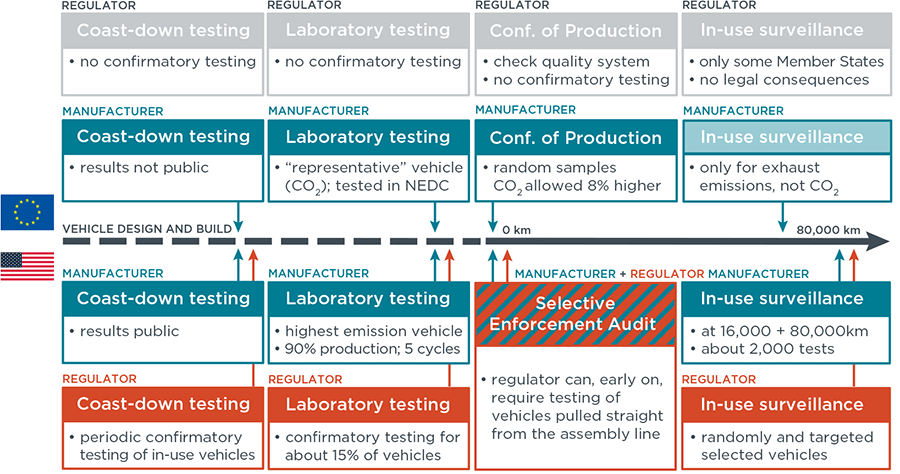Press release
Pinpointing weaknesses in Europe’s vehicle emissions testing scheme to point the way toward a more effective and robust program
A side-by-side comparison of the vehicle emissions testing arrangements in the United States and the European Union vividly demonstrates the consequences of a lack of crucial checks and balances in the EU’s system.
That is the central conclusion of a new study released today in Berlin by the International Council on Clean Transportation (ICCT).
The study analyzes and compares new-vehicle type-approval procedures in the EU and U.S. with an eye toward demonstrating how best to align regulatory requirements, customer expectations, and environmental performance.
The authors, Peter Mock and John German, highlight several key differences between the testing regimes in Europe and the U.S.
“The actual pre-production vehicle testing process in the laboratory is not so much different in Europe and the U.S.” said John German. “But in the U.S. the authorities carry out independent confirmatory testing on about 15 percent of all pre-production vehicle tests and have also established robust in-use testing programs.” These re-tests by the U.S. Environmental Protection Agency (EPA) and the California Air Resources Board (CARB) are very effective, as demonstrated not only in the recent VW case but also in prior investigations, and thereby encourage vehicle manufacturers to regard the spirit and intent when carrying out vehicle emissions testing.
“In the EU, independent re-testing of vehicle emissions is not foreseen at all by the regulations,” said Peter Mock. In practice, vehicle emissions testing is carried out or commissioned by the vehicle manufacturer itself. During the testing a representative of an accredited technical service company is present and witnessing the testing process, but is being paid for its services directly by the vehicle manufacturer. And there is no testing of in-use vehicles.
Vehicle manufacturers in the EU can also decide themselves in which member state they want their vehicles to be tested for type-approval. For example, the 2011 Volvo V70 1.6D DRIVe was type-approved in Spain, even though the vehicle is produced in Sweden. In the case of the 2011 BMW 116i, the emissions’ type-approval was carried out in Luxembourg. “The possibility for vehicle manufacturers to cherry-pick national type-approval authorities and technical service companies to witness vehicle emissions testing creates a potential conflict of interest,” said Mock. “The national type-approval authorities and the technical service companies compete among themselves for testing assignments and can therefore not be regarded as fully independent.”
The recent revelation that Volkswagen had used illegal software to permit some of its vehicles to pass type-approval or certification emissions tests, only to emit many times the regulatory limits in everyday driving, has drawn particular attention to the real-world emissions performance of modern diesel passenger cars. Previous ICCT studies have demonstrated that the nitrogen oxides (NOx) emissions of most recent Euro 6 diesel cars in the EU are, on average, about seven times higher under real-world driving conditions than the legal limit under laboratory testing conditions. Separate ICCT studies of fuel consumption and carbon dioxide (CO2) emissions have found that the real-world figures are, on average, about 40 percent higher than suggested by official manufacturers’ data.
The new study recommends establishing a European-wide type-approval authority that would co-ordinate vehicle emissions testing, breaking the direct connection between vehicle manufacturers and national type-approval authorities as well as technical service companies. The new EU authority should systematically carry out independent re-tests of vehicle emissions, similar to how the federal Environmental Protection Agency and the California Air Resources Board operate in the United Sates. To be most effective, testing would need to happen on in-use vehicles instead of ‘golden’ cars that are specially prepared by vehicle manufacturers for testing purposes. And testing should happen under real-world driving conditions, in addition to testing under laboratory conditions.
Publication details
The future of vehicle emissions testing and compliance: How to align regulatory requirements, customer expectations, and environmental performance in the European Union
Authors: Peter Mock and John German

